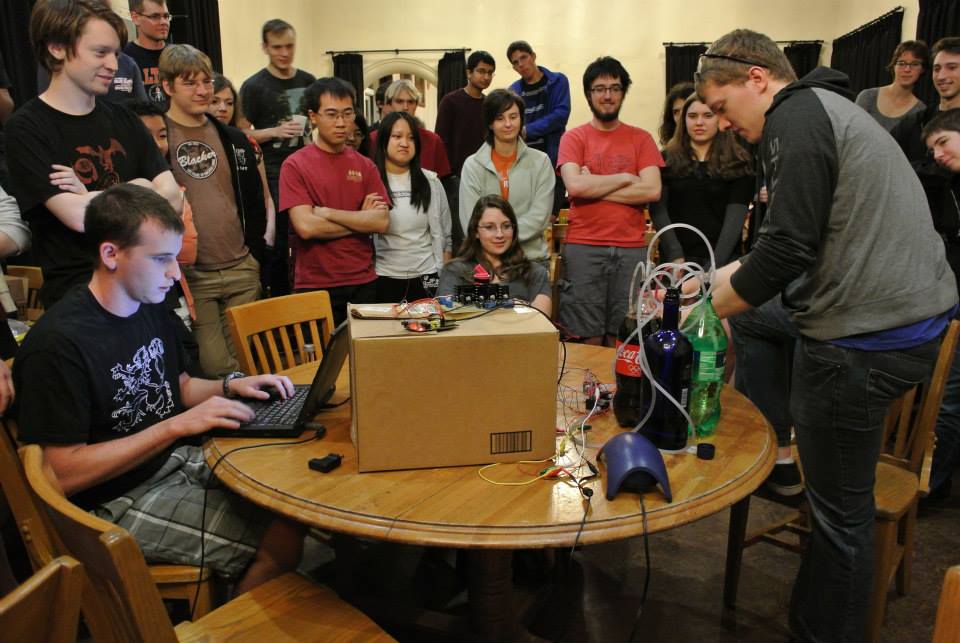Raspberry Pi powered robotic bartender, part 1
January 22, 2014
The goal of this project is to build an automated bartender that can dispense different drinks automatically when given the set of drinks connected to it. Also, the machine should be accessible using a smartphone.
Introduction
Justin Koch, project manager of the Caltech Robotics Team, handled the mechanical side namely how transport the drink from their bottle into a cup. I am handling the electrical and programming side.
The design we settled on (Feb 2013), based on this instructable is for an aquarium pump to pressurize the system and then use these valves on each drink line to dispense that drink. Now, I would suggest using these peristaltic pumps as they are more accurate and easier to use.
Electrical Design
Since the valves are effectively a solenoid, controlling them is very straight forward. All that is needed is an N-channel MOSFET on the low-side of the solenoid and a flyback diode across the solenoid to prevent inductive voltage spikes when the solenoid is disconnected. Here’s a schematic of the control circuit for one solenoid.

The 10K pulldown resistor makes sure MOSFET is off during power up.
The next question was what would drive the MOSFET. Because we wanted people to be able to order drinks from a web interface, we selected a Raspberry Pi as it makes it easy to setup as a wireless access point, has enough CPU resources to serve webpages easily and uses Linux. Because the Raspberry Pi has GPIO pins, all that is needed is to connect the gates of the MOSFETs to the GPIO pins.
Miscellaneous other parts needed include a 12V DC power supply for powering the solenoids, blade connectors for connecting to the solenoids, and my new favorite connector system, Molex SL connectors for connecting between the main circuit, Raspberry Pi and the solenoids.
Programming Design
With the solenoids hooked up, all that’s needed on the Raspberry Pi side is code to control the GPIO pins. I chose Python as the implementation language as there’s a nice library, RPi GPIO for controlling the GPIO pins and since I want to design a web interface Python has a lot of nice tools for web development. In terms of architecture, I chose an OOP-based design as I think objects are a great way to model the state of the machine and each drink recipe. The MachineState object holds the current configuration of the machine such as what pins are connected to which drink and how long to turn on a pin to output a given amount of liquid. The Recipe objects holds instructions for making a drink and is stored as a list of tuples of drink name and amount. Both the MachineState and Recipe objects have class methods for contructing these objects from configuration files allowing easy extension and configuration of how the machine is setup and what possible drinks are there.
At the start of the process, the main Python programs reads in the configuration file for the machine and setups the MachineState object. Then, it reads the recipe file and filters out recipes that can’t be made based on the current configuration of the machine. Finally, this main program uses the Flask web framework and handles the requests from web interface. Using the list of possible drinks, it returns a order page that contains only available drinks.
Currently, the order process is clunky as the machine pours the drink after receiving the POST request from the form, and only returns when the drink is done. One of the next features to implement is replacing the POST request with AJAX and making the response more dynamic by updating the page as each drink is poured.
First Implementation
Here’s what the first working demo looked like

Next Steps
After getting the demo working, there are a number of features and additions to be made. First, I want to replace the huge, ugly perfboard with a small simple PCB (that’s the next post). Then, actually implement the machine configuration file. After that comes building a drinks database and linking that into Flask. Also, I want to replace the slow, synchronous POST request and page change to order a drink with a AJAX-based UI that’s a lot snappier. Finally, I need to add admin functionality from the web interface so that I can add different ingredients and “purge” (pump water through the lines so that lines remain clean) the system without opening the system or SSH’ing into the Raspberry Pi.